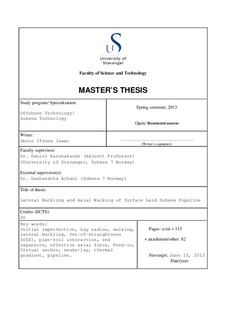| dc.description.abstract | Subsea pipelines are increasingly being required to operate at high temperature and pressure
HT/HP. The pipeline installed on the seabed and left exposed have a potential to buckle, walk
and change configuration under high temperature and pressure (HT/HP). This could lead to
failure of the Pipeline if buckling and walking is not properly controlled or mitigated.
The objective of the thesis work is to study and understand the influence of pipeline-soil
interaction on the design of surface laid subsea pipeline susceptible to lateral buckling and
pipeline walking.
The main focus of the thesis work is on the use of snake-lay configuration as a mitigating
measure under controlled buckling design and rock dumping if needed to limit feed-in into
buckle and end expansions; the effect of thermal gradient on axial walking and the use of direct
electric heating (DEH) to reduce rate of walking.
The snake-lay configuration is achieved by installing deliberate horizontal lay imperfection to
trigger a sufficient number of thermal buckles at a pre-determined location along the pipeline.
The desire is to limit pipeline expansion at the connecting ends by using snake-lay design with
intermittent rock dumping.
The work includes performing non-linear finite element analysis (FEA) and modeling the soilpipeline
interaction of as-laid pipeline using general finite (FE) element software ANSYS. The
results are discussed against the relevant design criteria based on design codes DNV-OS-F101,
DNV-RP-F110 and Subsea 7 Lateral Buckling Analysis Design Guideline.
FE analyses were performed to study the lateral buckling of a 2km VAS model with an initial
out-of-straightness (OOS) under operating temperature and pressure.
Consequently, the effect of thermal gradient of an asymmetric heating process in pipeline
walking phenomenon is investigated. Based on FE analyses findings, the use of direct electric
heating (DEH) system to reduce the rate of axial walking is proposed and explained.
Keywords: Initial imperfection, Lay radius, walking, lateral buckling, Out-of-straightness
(OOS), pipe-soil interaction, end expansion, effective axial force, Feed-in, Virtual
anchor, snake-lay, thermal gradient, pipeline, direct electric heating (DEH). | no_NO |
